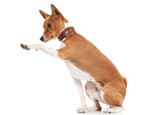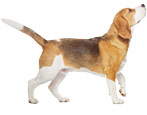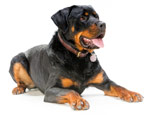Puppy feeding rules

A puppy is an amazing little friend, a complete family member, and a relationship requires it. If your dog brought puppies or you took a very small puppy into your family, sooner or later the question will arise when, how, how and in what quantity it can be supplemented.

General information
It is quite obvious that the best food for a small dog, as well as for a small human cub, is breast milk. It is rich not only in all the necessary substances, minerals, fats and carbohydrates, it is rich in antibodies - maternal immunity helps to protect offspring from dangerous diseases and numerous threats of the big world. By the age of 2 months, they do not need breast milk.
This does not mean at all that you need to wait until the puppies themselves want to eat something else, since milk for the growing offspring will soon cease to be enough. Therefore, already from the third week after birth, the puppy is given complementary foods.

To understand what the very first complementary food should be, it is necessary to take into account the imperfection of lipid metabolism in puppies and the fat content of the bitch's milk. Usually it is in the range from 7 to 10%, and it is precisely this fat content that should be those products that you offer as complementary foods to your pets. Only if this rule is observed, the puppy will not develop health problems.
Another rule of the first supplement says that you should not impose nutrition on the puppies from the outside if they sleep almost all the time and are gaining weight normally. Only when it is obvious that the puppies are not getting enough nutrition, they are restless, whine, sleep little, should you think about introducing supplementary feeding.

What to feed up to 1 month?
There are special mixtures that mimic the composition of the milk of bitches.If the mother cannot feed the puppies or there is not enough milk pathologically, it is worth introducing complementary feeding with such a mixture from a bottle first. Such mixtures are quite expensive, they are not affordable for everyone, and therefore the question arises whether it is possible to choose something else.
Veterinarians consider goat's milk a worthy substitute and the first supplement. The first time it needs to be slightly diluted with water, then you can give it whole, and after a few days you can add one raw yolk of a quail or chicken egg to the milk.
The earliest age to start the first feeding is 2-3 weeks from birth. The puppy should be taught to solid food from 1 month.


Nutrition after 1 month
The first solid food for a baby-puppy should be cottage cheese, the fat content of which does not exceed 9%. It is useful to add a raw egg to it, or rather, the yolk. With the number of eggs, it is important not to get excited - give no more than 1 egg per 200 grams of the total daily food intake. Also, from a month you can offer the puppy beef and veal - boiled, mashed in minced meat.
From five weeks, puppies are already quite autonomous, many breeders at this age give puppies into the wrong hands, and someone acquires dogs at this age. Now meat is very important for the pet - protein is necessary for the growth of muscles and tissues. Other varieties can be added to veal and beef, but a large amount of animal fat should be avoided, and therefore you should not experiment with pork, and you should definitely remove fat from chicken. You can gradually start giving raw minced meat. Milk is replaced by fermented milk products, for example, low-fat kefir or fermented baked milk.
If you plan to feed the puppy then with dry food, you can already take his granules and slightly soak them with milk or water - he cannot gnaw them yet. Gradually, by the age of two months, the baby will begin to eat "drying" without significant difficulties.



Nutrition for 1.5-2 months
One and a half months is the first serious age at which feeding a puppy turns into independent and complete nutrition. It is important to feed the pet according to the scheme up to 4-5 times a day, but the amount of food in each meal should not be large - the stomach, liver, pancreas and intestines of the baby are not yet ready for serious stress.
In a month and a half, you can enter raw fish into the pet's diet. But first, offer it the same, but boiled.
Make sure that the puppy does not choke on the bones, feed the fillets, and the fish bones can be used in a meal in a ground form - as bone meal for adding to cottage cheese, porridge.


Closer to 7 weeks of age, the puppy can begin to give vegetables and fruits. The first foods for complementary foods are apples and carrots, lettuce, fresh cucumbers, squash and pumpkin. The share of vegetable fiber should account for about 35% of the total composition of the dog's diet. Fruits and vegetables are given peeled, carefully chopped, if the dog refuses to eat them, add them to porridge or minced meat.
At 7 weeks, the puppy should receive beef bones - it is desirable to grind them, like fish bones, and the joints and veins can be allowed to chew, as a toy and as an excellent teether for milk teeth.


What to feed from 2 months?
At two months old, the puppy's digestion and immunity are already strong enough to expand the diet. From this time on, by-products are permissible - liver, lung. But with such products you need to be very careful. Chicken necks are easier to swallow, and therefore the puppy may not even chew them, but he will gnaw the chicken backs. A scar is acceptable, but in small quantities.
From two months, the feeding scheme is reduced to 3-4 per day, but the portions should be larger. The daily food volume is almost equal to the volume that an adult dog of a given size and breed should have. Male puppies start eating a little more than female puppies.
To make digestion softer and more delicate, from this age it is permissible to add chopped greens to food. Avoid strong-smelling greens, such as cilantro.From three months, the puppy switches to a full adult diet.


Useful Tips
In order for your dog to grow up healthy, be sure to train your puppy to eat fresh vegetables and fruits. If this is not done during a favorable period of childhood, it will be difficult for an adult dog to teach how to eat apples or carrots, and plant protein and fiber, like vitamins, are very necessary for a pet of any age, gender and breed.
Any food you introduce into your puppy's diet should start with a small amount. Do not introduce more than one new product per day, so that in case of an inadequate reaction to it, you can easily understand what exactly the puppy is not digesting or what he is allergic to.
Do not think that allergies are a purely human problem. Dog immunity works in a similar way and can perceive a new substance as an antigen. Allergy in a dog is manifested by itching - the puppy begins to itch, worry, eyes may water, possibly a liquid separable from the nasal passages. After noticing such symptoms, stop giving the questionable product and return to it in a couple of weeks. - Dogs, like human children, may well outgrow children's allergies on their own, and in the future they will not have problems with nutrition.


To help keep your puppy's weak digestive system safe, feed warm, but not hot. Cold food is also much less digestible and requires more energy from the body and enzymes.
If you decide to feed your dog natural food, be sure to check with your veterinarian. what vitamins can be given in addition. Even with a correctly and competently composed complementary food, it is difficult to provide a pet with all the necessary elements and substances.
If you feed with dry food, there is no need for additional intake of vitamin preparations, since an overdose can lead to hypervitaminosis, no less dangerous than a vitamin deficiency for a growing animal body.

See below for the first complementary foods for 3 week old Yokshire Terrier puppies.






































